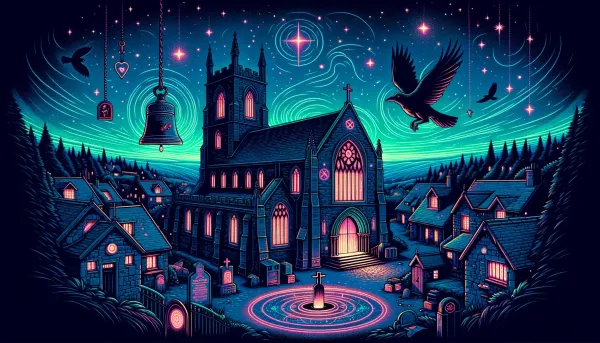Behind the Scenes: Exercises that Power My Character Creation

In fiction, characters are the lifeblood of any story. They are the ones who drive the plot, evoke emotion and interact with the reader's imagination. It's through these characters that we live the story, experience a range of emotions and explore different perspectives. As writers, creating convincing characters becomes our primary task, but it's far from easy.
Whether you're writing a novel, short story or screenplay, creating realistic, engaging characters can often be the most challenging part of the writing process. Characters aren't just names on a page; they're complex beings with backgrounds, personalities, quirks, fears, desires, and secrets. These intricate details are what make them relatable, interesting, and ultimately human.
This post contains a series of exercises designed to assist writers in the character creation process. The goal is to help you understand your characters better, so you can write about them more realistically and consistently.
Character Interview
Interviewing your character can be a powerful exercise, allowing you to delve deep into their psyche. This can not only enhance your understanding of them, but also help to shape their actions, reactions, and dialogue in the story.
Background:
- Where were you born and brought up?
- Can you tell me about your family? What were/are they like?
- Did you have a happy childhood? Why or why not?
- What was the most memorable moment of your childhood?
Interests
- What are your favourite hobbies or pastimes?
- What kind of books, music or art do you enjoy?
- Is there any special skill or talent that you have or would like to have?
Relationships:
- Who is the most important person in your life right now? And why?
- How do you get along with other people in general?
- Have you ever been in love? What was it like?
Fears:
- What are you most afraid of?
- Have you ever had to face this fear?
- How do you react when you are afraid?
Dreams:
- What is the biggest dream you have in your life?
- What steps are you taking or planning to take to achieve it?
- How would achieving this goal change your life?
Secrets:
- Do you have any secrets that you've never told anyone?
- How do those secrets affect you?
- What would happen if those secrets were revealed?
Beliefs:
- What do you believe about life and death?
- What are your moral or ethical values?
- Have your beliefs ever been questioned or changed? How and why?
Past and Future:
- What is your biggest regret?
- If you could change one thing about your past, what would it be and why?
- Where do you see yourself in five or ten years' time?
Quirks and peculiarities:
- Do you have any habits or routines that others might find unusual or quirky?
- Do you have any physical characteristics that set you apart from others?
- Do you have any interests or hobbies that would be considered unusual or peculiar by most people?
- How do you behave in social situations? Do you behave in any way that stands out?
- Do you have a unique way of speaking, such as an accent, a speech impediment, or certain phrases that you use a lot?
- Are there certain foods, clothes, or environments that you particularly like or dislike?
- Do you have any fears or phobias that others might find unusual?
- Are there certain situations that cause you to react in a peculiar way?
It's important to treat this exercise as a real conversation. Allow your character's answers to shape the course of the conversation, even if it means straying from the listed questions. This allows for organic character development and exploration. Remember, not every character detail will appear in your story. What's important is the understanding and depth you have of your characters as a writer.
Genre-specific freewriting from the character's point of view
I have written about the benefits of free writing sessions in a previous post inspiration.garden. Engaging your character with the elements of your chosen genre can add depth to their personality and lead to more nuanced writing. Genre-specific free writing exercises are an invaluable tool in this endeavour.
By placing your character in scenarios and settings that resonate with your genre, you give them unique experiences to deal with. This approach helps to study their reactions, adaptations, and the strategies they use to overcome the challenges presented by these environments.
Here are some genre-specific scenarios and settings for your characters:
Scenarios
Romance
- Your character is preparing for his first date with someone they've admired from afar.
- Your character decides to express their feelings to their best friend.
- Your character comes to terms with the fact that their significant other may not be the person they thought they were.
Fantasy
- Your character experiences their magical powers for the first time.
- A mythical creature picks your character as its mate or master.
- Your character is tasked with uniting warring magical factions against a common enemy.
Thriller/Suspense
- Your character wakes up in an unknown place with no memory of how he got there.
- Your character learns that they are being pursued by an unidentified entity.
- Your character stumbles upon a strange object, setting off a series of dangerous events.
Magical Realism
- A mystical creature begins to appear in your character's mundane life.
- Your character realises that their dreams affect reality in unexpected ways.
- Your character discovers that an everyday object, such as a mirror or a book, has extraordinary powers.
LGBT
- Your character reveals their true sexuality to family or friends.
- Your character explores their gender identity and considers transitioning.
- Your character is navigating societal prejudices while in a new relationship.
Science Fiction
- Your character becomes the first human to interact with an alien life form.
- Your character invents a technology that can transform society, but it has a dangerous flaw.
- Your character awakens from an extended cryosleep to find that he is the only person left on his spaceship.
Adventure
- Your character is part of an expedition to unexplored territories, where they encounter an unforeseen obstacle.
- Your character finds a treasure map that sets them on an exciting hunt for hidden treasure.
- After a plane crash, your character must use their wits and limited resources to survive in the wilderness.
Setting
Romance
- A cosy café where your character regularly meets their love interest.
- A quaint seaside town where your character heals from heartbreak.
Fantasy
- A royal court full of political intrigue for your character to navigate.
- A mystical forest where your character searches for a legendary creature or artefact.
Thriller/Suspense
- An abandoned warehouse where your character is guided by a cryptic clue.
- A high-tech corporate facility where illegal activities are taking place.
Magical Realism
- Your character's home, where ordinary objects have magical properties.
- A bustling marketplace where traders trade memories or dreams.
LGBT
- A community centre where your character can find acceptance and support.
- A large, vibrant city where your character moves to embrace their identity openly.
Science Fiction
- A vast spaceship that serves as your character's home.
- A dystopian city in the future where your character is part of a rebellion.
Adventure
- The base camp of a dangerous mountain that your character is preparing to climb.
- An ancient temple full of traps where your character is searching for a forgotten artefact.
Use these scenarios and settings as springboards for your free writing sessions. Let your character drive the narrative, surprise you and reveal unknown facets of their personality. The ultimate goal is to gain a more profound understanding of your character and their approach to navigating their world, especially within the parameters of your chosen genre.
Creating a Character Bucket List
A character bucket list is a unique and powerful tool for exploring your character's deepest desires, ambitions, and motivations. It's essentially a list of experiences, accomplishments, or tasks that your character hopes to achieve in their lifetime.
This method not only reveals a great deal about the character's values and dreams, but can also reveal compelling plot ideas and conflicts.
The bucket list should be consistent with the character's personality, background, and current circumstances, all of which you have explored through the character interview and free writing sessions. Remember that the items on the list should be significant to the character and have some emotional resonance.
Here's a step-by-step process for creating a character bucket list:
1. Think about your character: Start by reviewing your character interview and the insights you gained from the free writing sessions. Think about your character's interests, fears, dreams, and motivations.
2. Brainstorm: Keeping your character's traits in mind, brainstorm a list of things they would like to accomplish, experience, or achieve. These can range from personal goals such as 'start a family' or 'write a book' to more adventurous or unconventional ones such as 'go on a space voyage' or 'join a secret society'. They can also be related to the character's personal growth, such as overcoming a fear or breaking a habit.
3. Prioritise: Not all items on the bucket list are equally important. Rank the items based on what your character would consider most important to least important. This can tell you a lot about their priorities and what they value most in life.
4. Consider plot implications: Look at each item and think about how you could incorporate it into your story. Could any of them serve as a subplot or even the main plot? Could they create conflict or contribute to character development?
5. Review and Refine: As your story progresses and your character develops, return to this list. Add, remove, or modify items based on your character's experiences and growth throughout the story.
Creating a character bucket list is more than an exploratory exercise—it's a dynamic tool that grows with your story and your character. It can provide plot inspiration, create opportunities for character development, and add depth to your character, making them more relatable and real to your readers.
Creating Character Biographies
Developing comprehensive biographies for your characters is a key exercise in fiction writing. It serves as an insightful reference tool, detailing aspects from your characters' early years to their present circumstances and providing a complete narrative of their life's journey.
In addition, these narratives often reveal new story concepts or plot points.
Using the answers from the character interview, the insights from the genre-specific free writing sessions, and the findings from the character's bucket list can greatly enrich the process of writing the biography. Your character's voice, quirks, unique attributes, and deepest desires all contribute to creating a vivid, believable portrait.
Let's look at how to write a comprehensive character bio:
1. Start with basic information: Use the character interview to include basic information such as name, age, physical appearance, and occupation. Use this section to outline any defining physical characteristics your character might have.
2. Childhood and Education: Explore your character's early life. Where were they born? What was their family structure like? Were there any significant childhood events that shaped their personality? What kind of student were they, and in what subjects did they excel or struggle?
3. Work and skills: Based on your character's age and history, describe their work experience and any special skills they may have. If they're a student or retired, what are they studying or doing for a living?
4. Relationships: Delve into their interpersonal relationships. Who are the important people in their lives? How do they relate to others? Use the insights from the interview questions about their relationships with others.
5. Defining Moments: Identify key moments in your character's life that have had a significant impact on them. These could be joyful occasions, traumatic experiences or life-changing decisions. They can reveal a lot about a character's motivations, fears, and desires.
6. Personal Aspirations: Use the character's bucket list to understand your character's ambitions, dreams, and desires. These can suggest possible plot points, conflicts, and character development arcs. In addition, this list provides insight into your character's values, passions, and goals, thereby enriching the biography.
7. Present life and circumstances: What is your character's life like when your story begins? Think about their living situation, their job, their relationships, and any challenges they might face.
8. Goals and motivations: Using the information from the character interview, the bucket list, and the insights from your free writing session, describe your character's current goals and what's driving them towards them. What obstacles stand in their way? How have the situations and settings from your free writing session influenced these goals and motivations?
Creating character biographies is not a one-off pre-writing exercise; it's a living document that evolves with your story. As your story unfolds, your characters will grow and change. Regularly updating the biographies ensures that your characters remain consistent, believable, and relatable, helping you to understand their motivations and actions in the context of their life experiences. As you weave your story, these biographies will also serve as a valuable reference point, keeping your characters' past and present easily accessible.
Characters are at the heart of every story. They drive the narrative, engage the reader, and bring your fictional world to life. I hope this guide gives you the tools to create dynamic, memorable characters that will enrich your story and captivate your readers.
Remember, writing is a process, and creating characters is no exception. Enjoy the journey of discovering your characters and bringing them to life in your writing. You're not just creating characters, you're creating lives. And in doing so, you're creating a world that your readers will want to get lost in.




